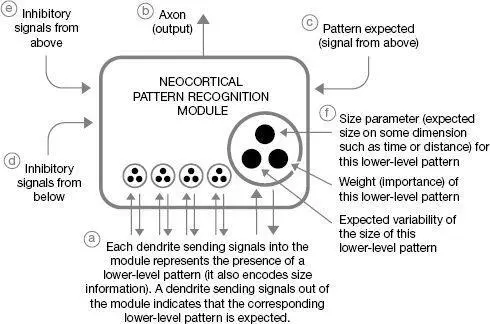
The second part of each pattern is the pattern’s name. In the world of language, this higher-level pattern is simply the word “apple.” Although we directly use our neocortex to understand and process every level of language, most of the patterns it contains are not language patterns per se. In the neocortex the “name” of a pattern is simply the axon that emerges from each pattern processor; when that axon fires, its corresponding pattern has been recognized. The firing of the axon is that pattern recognizer shouting the name of the pattern: “Hey guys, I just saw the written word ‘apple.’”
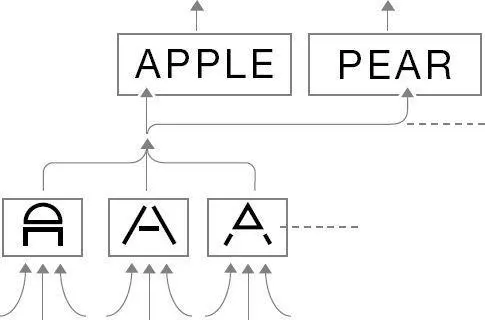
Three redundant (but somewhat different) patterns for “A” feeding up to higher-level patterns that incorporate “A.”
The third and final part of each pattern is the set of higher-level patterns that it in turn is part of. For the letter “A,” this is all of the words that include “A.” These are, again, like Web links. Each recognized pattern at one level triggers the next level that part of that higher-level pattern is present. In the neocortex, these links are represented by physical dendrites that flow into neurons in each cortical pattern recognizer. Keep in mind that each neuron can receive inputs from multiple dendrites yet produces a single output on an axon. That axon, however, can then in turn transmit to multiple dendrites.
To take some simple examples, the simple patterns on the next page are a small subset of the patterns used to make up printed letters. Note that every level constitutes a pattern. In this case, the shapes are patterns, the letters are patterns, and the words are also patterns. Each of these patterns has a set of inputs, a process of pattern recognition (based on the inputs that take place in the module), and an output (which feeds to the next higher level of pattern recognizer).
Southwest to north-central connection:

Southeast to north-central connection:

Horizontal crossbar:

Leftmost vertical line:

Concave region facing south:

Bottom horizontal line:

Top horizontal line:

Middle horizontal line:

Loop constituting upper region:

The above patterns are constituents of the next higher level of pattern, which is a category called printed letters (there is no such formal category within the neocortex, however; indeed, there are no formal categories).
“A”:
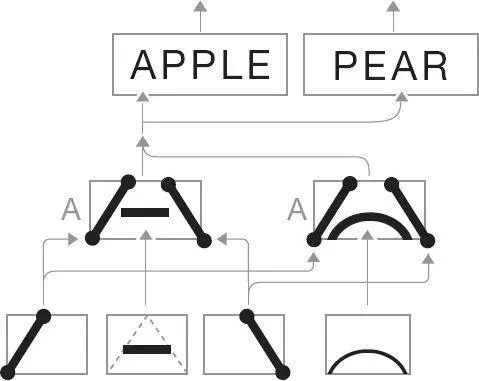
Two different patterns, either of which constitutes “A,” and two different patterns at a higher level (“APPLE” and “PEAR”) of which “A” is a part.
“P”:
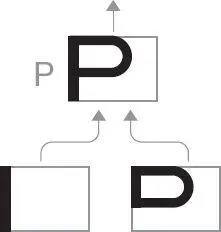
Patterns that are part of the higher-level pattern “P.”
“L”:
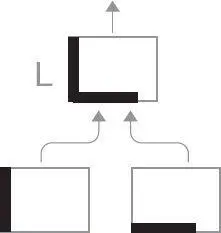
Patterns that are part of the higher-level pattern “L.”
“E”:
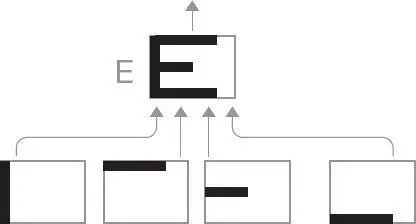
Patterns that are part of the higher-level pattern “E.”
These letter patterns feed up to an even higher-level pattern in a category called words. (The word “words” is our language category for this concept, but the neocortex just treats them only as patterns.)
“APPLE”:
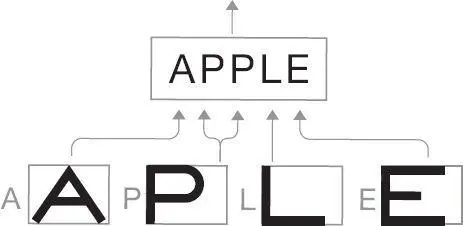
In a different part of the cortex is a comparable hierarchy of pattern recognizers processing actual images of objects (as opposed to printed letters). If you are looking at an actual apple, low-level recognizers will detect curved edges and surface color patterns leading up to a pattern recognizer firing its axon and saying in effect, “Hey guys, I just saw an actual apple.” Yet other pattern recognizers will detect combinations of frequencies of sound leading up to a pattern recognizer in the auditory cortex that might fire its axon indicating, “I just heard the spoken word ‘apple.’”
Keep in mind the redundancy factor—we don’t just have a single pattern recognizer for “apple” in each of its forms (written, spoken, visual). There are likely to be hundreds of such recognizers firing, if not more. The redundancy not only increases the likelihood that you will successfully recognize each instance of an apple but also deals with the variations in real-world apples. For apple objects, there will be pattern recognizers that deal with the many varied forms of apples: different views, colors, shadings, shapes, and varieties.
Also keep in mind that the hierarchy shown above is a hierarchy of concepts . These recognizers are not physically placed above each other; because of the thin construction of the neocortex, it is physically only one pattern recognizer high. The conceptual hierarchy is created by the connections between the individual pattern recognizers.
An important attribute of the PRTM is how the recognitions are made inside each pattern recognition module. Stored in the module is a weight for each input dendrite indicating how important that input is to the recognition. The pattern recognizer has a threshold for firing (which indicates that this pattern recognizer has successfully recognized the pattern it is responsible for). Not every input pattern has to be present for a recognizer to fire. The recognizer may still fire if an input with a low weight is missing, but it is less likely to fire if a high-importance input is missing. When it fires, a pattern recognizer is basically saying, “The pattern I am responsible for is probably present.”
Successful recognition by a module of its pattern goes beyond just counting the input signals that are activated (even a count weighted by the importance parameter). The size (of each input) matters. There is another parameter (for each input) indicating the expected size of the input, and yet another indicating how variable that size is. To appreciate how this works, suppose we have a pattern recognizer that is responsible for recognizing the spoken word “steep.” This spoken word has four sounds: [s], [t], [E], and [p]. The [t] phoneme is what is known as a “dental consonant,” meaning that it is created by the tongue creating a burst of noise when air breaks its contact with the upper teeth. It is essentially impossible to articulate the [t] phoneme slowly. The [p] phoneme is considered a “plosive consonant” or “oral occlusive,” meaning that it is created when the vocal tract is suddenly blocked (by the lips in the case of [p]) so that air no longer passes. It is also necessarily quick. The [E] vowel is caused by resonances of the vocal cord and open mouth. It is considered a “long vowel,” meaning that it persists for a much longer period of time than consonants such as [t] and [p]; however, its duration can be quite variable. The [s] phoneme is known as a “sibilant consonant,” and is caused by the passage of air against the edges of the teeth, which are held close together. Its duration is typically shorter than that of a long vowel such as [E], but it is also variable (in other words, the [s] can be said quickly or you can drag it out).
Читать дальше




























